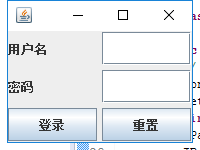public class asd extends JFrame {
public asd() {
// TODO Auto-generated constructor stub
Container c = getContentPane();
setLayout(new GridLayout(3, 1, 5, 5));
final JPanel jp1 = new JPanel();
JPanel jp2 = new JPanel();
JPanel jp3 = new JPanel();
jp1.setLayout(new GridLayout(1, 2, 5, 5));
jp2.setLayout(new GridLayout(1, 2, 5, 5));
jp3.setLayout(new GridLayout(1, 2, 5, 5));
jp1.add(new JLabel("用户名"));
final JTextField jt = new JTextField();
jp1.add(jt);
jp2.add(new JLabel("密码"));
final JPasswordField jp = new JPasswordField();
jp2.add(jp);
JButton jb1 = new JButton("登录");
JButton jb2 = new JButton("重置");
jp3.add(jb1);
jp3.add(jb2);
jb1.addActionListener(new ActionListener() {
@Override
public void actionPerformed(ActionEvent e) {
// TODO Auto-generated method stub
if (jt.getText().trim().equals("mr")&&jp.getText().trim().equals("mrsoft")) {
JOptionPane.showMessageDialog(null, "登陆成功");
}
else{
JOptionPane.showMessageDialog(null, "登陆失败,用户名或密码错误");
}
}
});
jb2.addActionListener(new ActionListener() {
@Override
public void actionPerformed(ActionEvent e) {
// TODO Auto-generated method stub
jt.setText("");
jp.setText("");
}
});
c.add(jp1);
c.add(jp2);
c.add(jp3);
setSize(200, 150);
setVisible(true);
setDefaultCloseOperation(WindowConstants.EXIT_ON_CLOSE);
}
public static void main(String[] args) {
// TODO Auto-generated method stub
new asd();
}
}






 浙公网安备 33010602011771号
浙公网安备 33010602011771号